Unit 9 I like music that I can dance to 单元教学设计 人教新目标(Go for it)版九年级全册
文档属性
| 名称 | Unit 9 I like music that I can dance to 单元教学设计 人教新目标(Go for it)版九年级全册 | 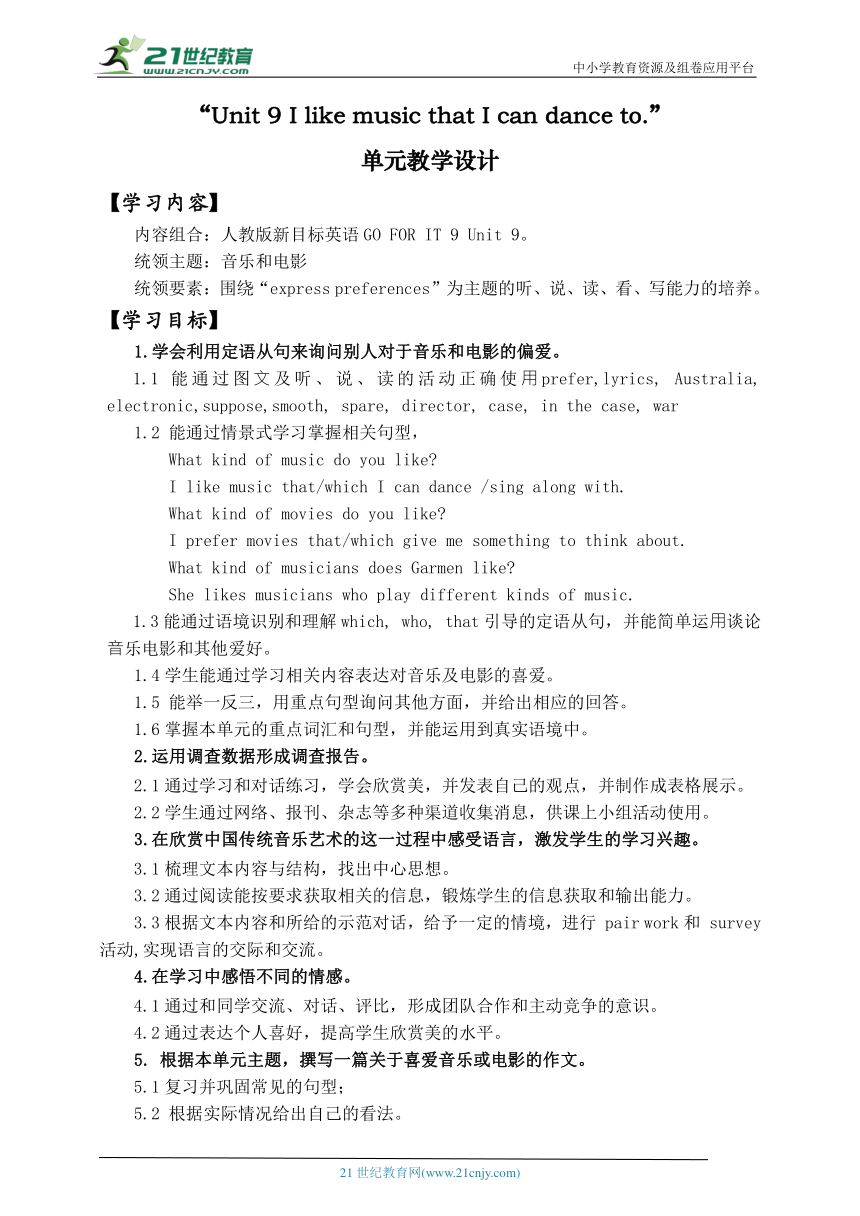 | |
| 格式 | doc | ||
| 文件大小 | 467.1KB | ||
| 资源类型 | 试卷 | ||
| 版本资源 | 人教新目标(Go for it)版 | ||
| 科目 | 英语 | ||
| 更新时间 | 2025-08-23 18:14:36 | ||
图片预览

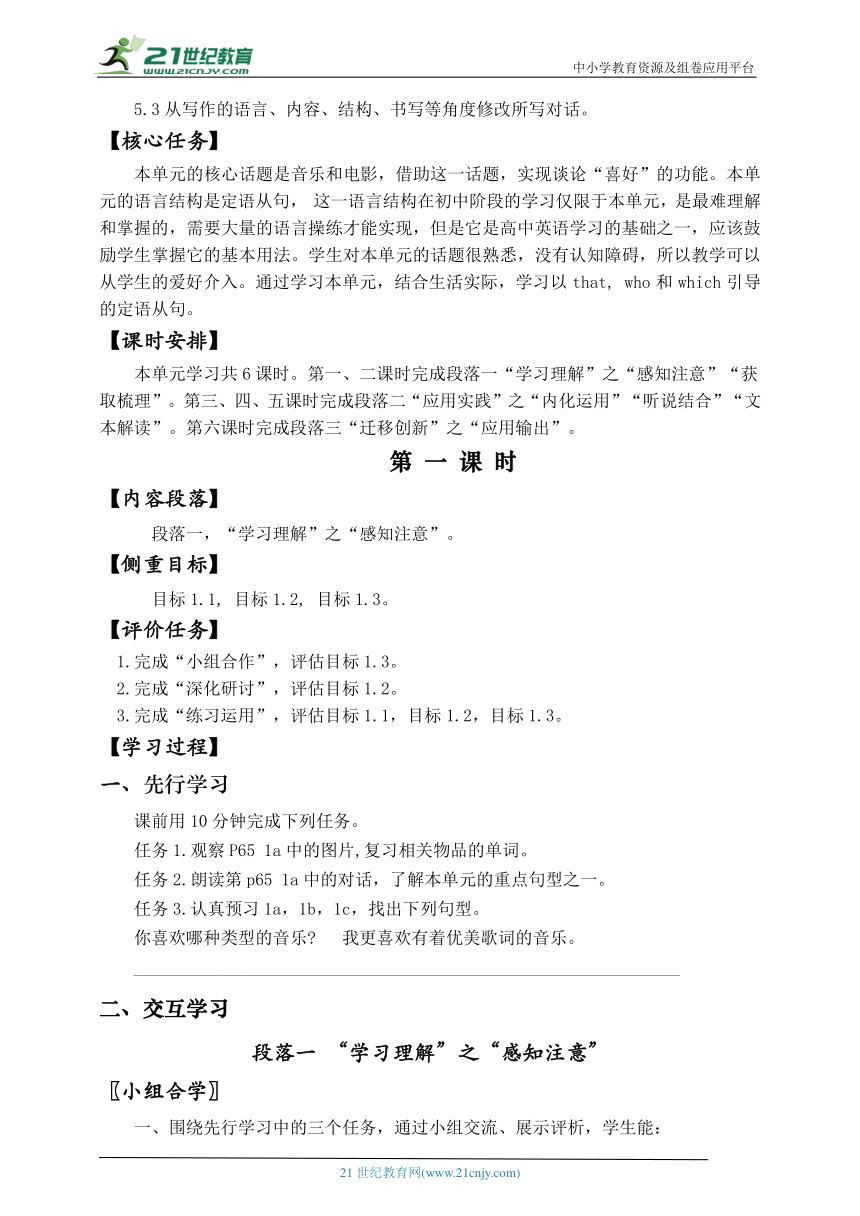
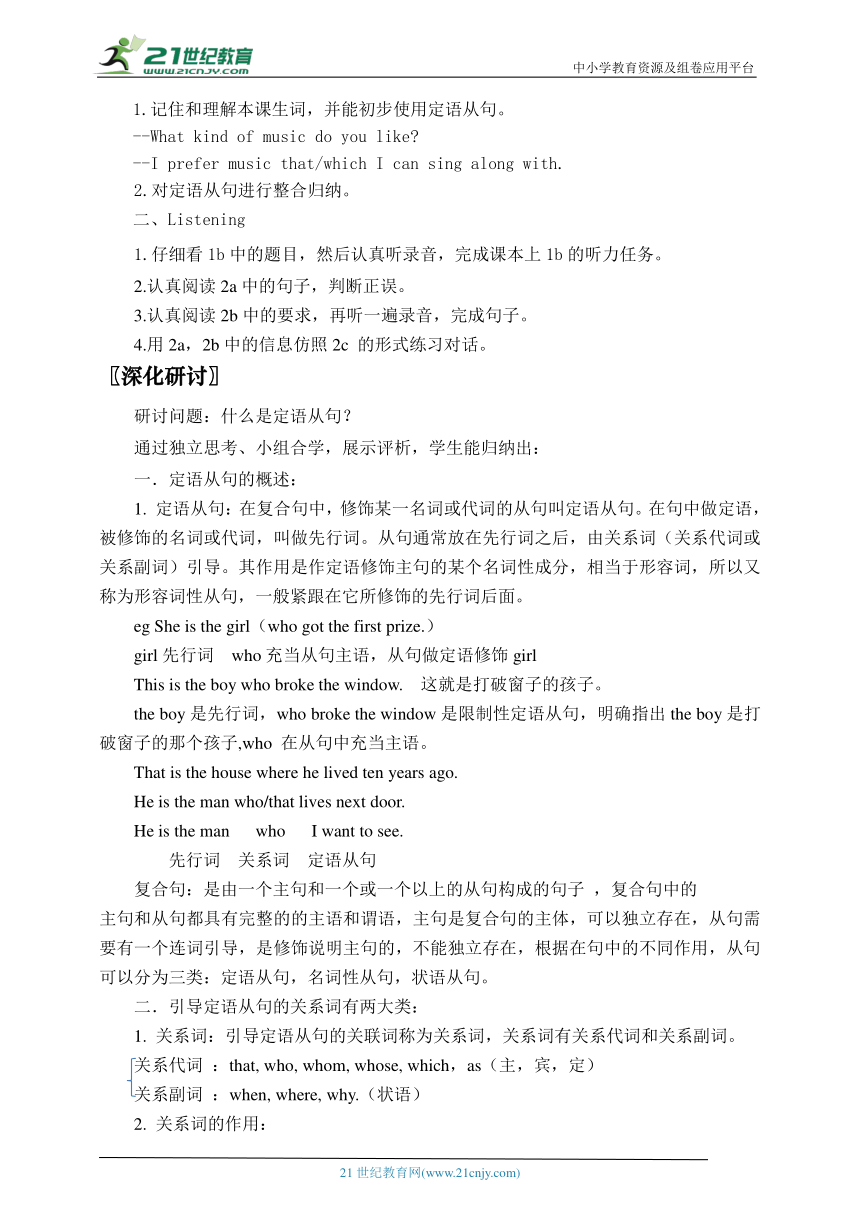
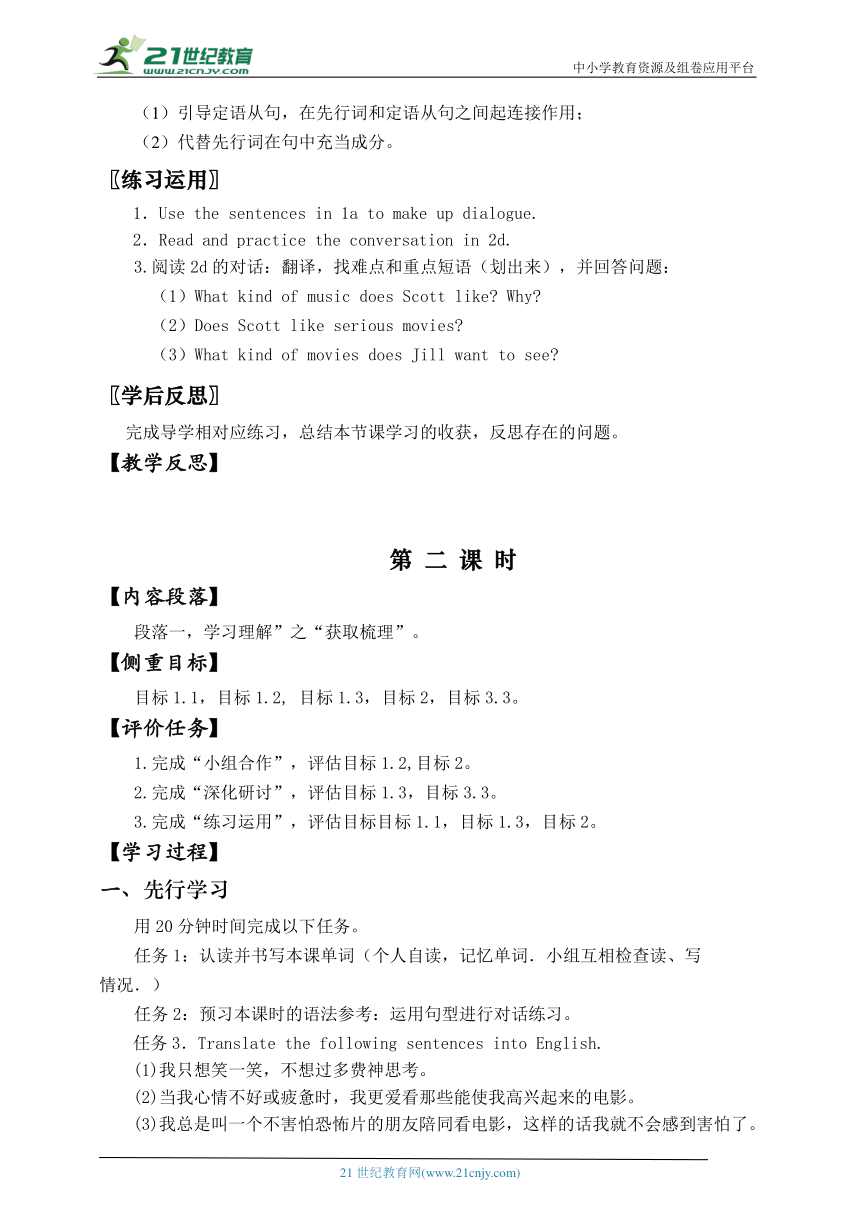
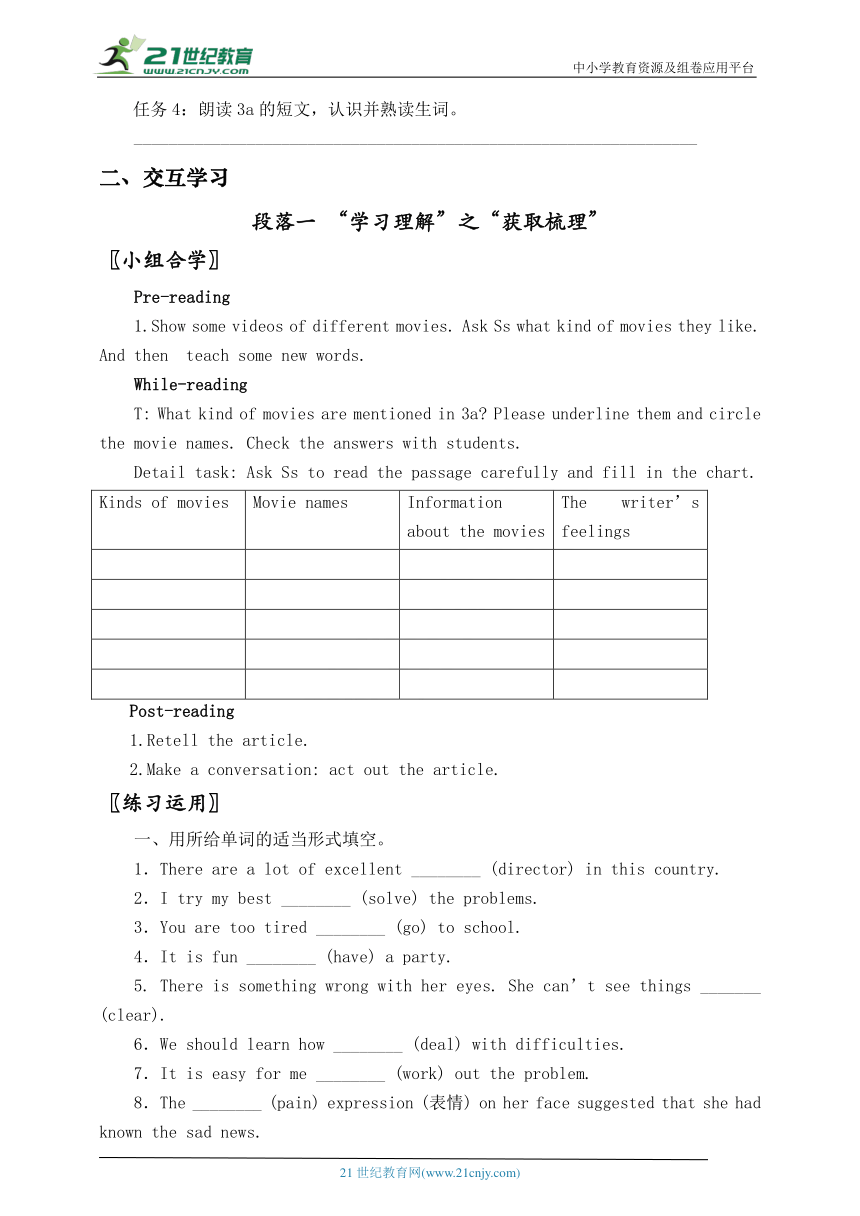
文档简介
中小学教育资源及组卷应用平台
“Unit 9 I like music that I can dance to.”
单元教学设计
【学习内容】
内容组合:人教版新目标英语GO FOR IT 9 Unit 9。
统领主题:音乐和电影
统领要素:围绕“express preferences”为主题的听、说、读、看、写能力的培养。
【学习目标】
1.学会利用定语从句来询问别人对于音乐和电影的偏爱。
1.1能通过图 及听、说、读的活动正确使 prefer,lyrics, Australia, electronic,suppose,smooth, spare, director, case, in the case, war
1.2 能通过情景式学习掌握相关句型,
What kind of music do you like
I like music that/which I can dance /sing along with.
What kind of movies do you like
I prefer movies that/which give me something to think about.
What kind of musicians does Garmen like
She likes musicians who play different kinds of music.
1.3能通过语境识别和理解which, who, that引导的定语从句,并能简单运 谈论 乐电影和其他爱好。
1.4学生能通过学习相关内容表达对音乐及电影的喜爱。
1.5 能举一反三,用重点句型询问其他方面,并给出相应的回答。
1.6掌握本单元的重点词汇和句型,并能运用到真实语境中。
2.运用调查数据形成调查报告。
2.1通过学习和对话练习,学会欣赏美,并发表自己的观点,并制作成表格展示。
2.2学生通过网络、报刊、杂志等多种渠道收集消息,供课上小组活动使用。
3.在欣赏中国传统音乐艺术的这一过程中感受语言,激发学生的学习兴趣。
3.1梳理文本内容与结构,找出中心思想。
3.2通过阅读能按要求获取相关的信息,锻炼学生的信息获取和输出能力。
3.3根据文本内容和所给的示范对话,给予一定的情境,进行 pair work和 survey活动,实现语言的交际和交流。
4.在学习中感悟不同的情感。
4.1通过和同学交流、对话、评比,形成团队合作和主动竞争的意识。
4.2通过表达个人喜好,提高学生欣赏美的水平。
根据本单元主题,撰写一篇关于喜爱音乐或电影的作文。
5.1复习并巩固常见的句型;
5.2 根据实际情况给出自己的看法。
5.3从写作的语言、内容、结构、书写等角度修改所写对话。
【核心任务】
本单元的核心话题是音乐和电影,借助这一话题,实现谈论“喜好”的功能。本单元的语言结构是定语从句, 这一语言结构在初中阶段的学习仅限于本单元,是最难理解和掌握的,需要大量的语言操练才能实现,但是它是高中英语学习的基础之一,应该鼓励学生掌握它的基本用法。学生对本单元的话题很熟悉,没有认知障碍,所以教学可以从学生的爱好介入。通过学习本单元,结合生活实际,学习以that, who和which引导的定语从句。
【课时安排】
本单元学习共6课时。第一、二课时完成段落一“学习理解”之“感知注意”“获取梳理”。第三、四、五课时完成段落二“应用实践”之“内化运用”“听说结合”“文本解读”。第六课时完成段落三“迁移创新”之“应用输出”。
第 一 课 时
【内容段落】
段落一,“学习理解”之“感知注意”。
【侧重目标】
目标1.1, 目标1.2, 目标1.3。
【评价任务】
1.完成“小组合作”,评估目标1.3。
2.完成“深化研讨”,评估目标1.2。
3.完成“练习运用”,评估目标1.1,目标1.2,目标1.3。
【学习过程】
一、先行学习
课前用10分钟完成下列任务。
任务1.观察P65 1a中的图片,复习相关物品的单词。
任务2.朗读第p65 1a中的对话,了解本单元的重点句型之一。
任务3.认真预习1a,1b,1c,找出下列句型。
你喜欢哪种类型的音乐 我更喜欢有着优美歌词的音乐。
_______________________________________________________________
二、交互学习
段落一 “学习理解”之“感知注意”
〖小组合学〗
一、围绕先行学习中的三个任务,通过小组交流、展示评析,学生能:
1.记住和理解本课生词,并能初步使用定语从句。
--What kind of music do you like
--I prefer music that/which I can sing along with.
2.对定语从句进行整合归纳。
二、Listening
1.仔细看1b中的题目,然后认真听录音,完成课本上1b的听力任务。
2.认真阅读2a中的句子,判断正误。
3.认真阅读2b中的要求,再听一遍录音,完成句子。
4.用2a,2b中的信息仿照2c 的形式练习对话。
〖深化研讨〗
研讨问题:什么是定语从句?
通过独立思考、小组合学,展示评析,学生能归纳出:
一.定语从句的概述:
1. 定语从句:在复合句中,修饰某一名词或代词的从句叫定语从句。在句中做定语,被修饰的名词或代词,叫做先行词。从句通常放在先行词之后,由关系词(关系代词或关系副词)引导。其作用是作定语修饰主句的某个名词性成分,相当于形容词,所以又称为形容词性从句,一般紧跟在它所修饰的先行词后面。
eg She is the girl(who got the first prize.)
girl先行词 who充当从句主语,从句做定语修饰girl
This is the boy who broke the window. 这就是打破窗子的孩子。
the boy是先行词,who broke the window是限制性定语从句,明确指出the boy是打破窗子的那个孩子,who 在从句中充当主语。
That is the house where he lived ten years ago.
He is the man who/that lives next door.
He is the man who I want to see.
先行词 关系词 定语从句
复合句:是由一个主句和一个或一个以上的从句构成的句子 ,复合句中的
主句和从句都具有完整的的主语和谓语,主句是复合句的主体,可以独立存在,从句需要有一个连词引导,是修饰说明主句的,不能独立存在,根据在句中的不同作用,从句可以分为三类:定语从句,名词性从句,状语从句。
二.引导定语从句的关系词有两大类:
1. 关系词:引导定语从句的关联词称为关系词,关系词有关系代词和关系副词。
关系代词 :that, who, whom, whose, which,as(主,宾,定)
关系副词 :when, where, why.(状语)
2. 关系词的作用:
(1)引导定语从句,在先行词和定语从句之间起连接作用;
(2)代替先行词在句中充当成分。
〖练习运用〗
1.Use the sentences in 1a to make up dialogue.
2.Read and practice the conversation in 2d.
3.阅读2d的对话:翻译,找难点和重点短语(划出来),并回答问题:
(1)What kind of music does Scott like Why
(2)Does Scott like serious movies
(3)What kind of movies does Jill want to see
〖学后反思〗
完成导学相对应练习,总结本节课学习的收获,反思存在的问题。
【教学反思】
第 二 课 时
【内容段落】
段落一,学习理解”之“获取梳理”。
【侧重目标】
目标1.1,目标1.2, 目标1.3,目标2,目标3.3。
【评价任务】
1.完成“小组合作”,评估目标1.2,目标2。
2.完成“深化研讨”,评估目标1.3,目标3.3。
3.完成“练习运用”,评估目标目标1.1,目标1.3,目标2。
【学习过程】
一、先行学习
用20分钟时间完成以下任务。
任务1:认读并书写本课单词(个人自读,记忆单词.小组互相检查读、写
情况.)
任务2:预习本课时的语法参考:运用句型进行对话练习。
任务3.Translate the following sentences into English.
(1)我只想笑一笑,不想过多费神思考。
(2)当我心情不好或疲惫时,我更爱看那些能使我高兴起来的电影。
(3)我总是叫一个不害怕恐怖片的朋友陪同看电影,这样的话我就不会感到害怕了。
任务4:朗读3a的短文,认识并熟读生词。
_________________________________________________________________
二、交互学习
段落一 “学习理解”之“获取梳理”
〖小组合学〗
Pre-reading
1.Show some videos of different movies. Ask Ss what kind of movies they like. And then teach some new words.
While-reading
T: What kind of movies are mentioned in 3a Please underline them and circle the movie names. Check the answers with students.
Detail task: Ask Ss to read the passage carefully and fill in the chart.
Kinds of movies Movie names Information about the movies The writer’s feelings
Post-reading
1.Retell the article.
2.Make a conversation: act out the article.
〖练习运用〗
一、用所给单词的适当形式填空。
1.There are a lot of excellent ________ (director) in this country.
2.I try my best ________ (solve) the problems.
3.You are too tired ________ (go) to school.
4.It is fun ________ (have) a party.
5. There is something wrong with her eyes. She can’t see things _______ (clear).
6.We should learn how ________ (deal) with difficulties.
7.It is easy for me ________ (work) out the problem.
8.The ________ (pain) expression (表情) on her face suggested that she had known the sad news.
9.Could you tell me where ________ (go) to the hotel
10.Would you mind ________ (do) his work
〖学后反思〗
1.梳理和绘制学习本单元A部分的“express preferences”话题思维导图。
2.完成导学作业,总结本节课的学习收获,反思学习中存在的问题。
【教学反思】
第 三 课 时
【内容段落】
段落二,“应用实践”之“内化运用”。
【侧重目标】
目标1.2,目标1.3,目标2.2,目标3.2,目标3.3。
【评价任务】
1.完成“小组合作”,评估目标1.2,目标1.3,目标 3.2。
2.完成“深度研学”,评估目标3.3。
3.完成“练习运用”,评估目标2.2。
【学习过程】
先行学习
课前用20分钟时间独立完成以下任务。
任务1:熟读并识记本单元的重点词汇。
任务2. 阅读Grammar Focus,并找出规律。
______________________________________
任务3:回忆各类时态中的被动语态的用法。
二、交互学习
段落二 “应用实践”之“内化运用”
〖小组合学〗
围绕先行学习中的三个任务,通过小组合学、展示评析,学生能:
1.Practice:look at the pictures, please make up conversations about them using the sentences in Grammar Focus.
2.read the sentences in Grammar Focus and repeat.
3.complete 4a alone.
4.ask Ss to work alone to finish 4b. Pay attention to attributive clause.
5.Group work: make conversations about the kind of things you like and dislike. Please discuss your ideas with partner.
〖深化研讨〗
研讨问题:定语从句的分类。
通过独立思考、小组合学,学生能归纳其语法特征:
定语从句的分类:
限制性定语从句
非限制性定语从句
限定性定语从句:限制性定语从句是先行词在意义上不可缺少的定语,如果去掉,主句的意思就不完整或者失去意义。从句和主句的关系十分密切,不可用逗号隔开,也不可省略。
eg She has found the necklace that she lost two weeks ago.
That代替先行词necklace,在从句中充当lost的宾语
The man who spoke last was Dr Li.
Who代替先行词man在从句中充当主语
2. 非限制性定语从句:从句和主句的关系不是十分密切,从句只是对先行词作些附加的说明,如果去掉,主句的意思仍然清楚完整,这种从句和主句之间往往用逗号分开,一般不用that引导。
eg Lijiang, (where I was born), is very beautiful.
关系副词where代替先行词Lijiang,在从句中充当地点状语,如果去掉从句,主句依然完整,这就称为非限制定语从句。
I , who am your friend, will share the work with you. 我是你的朋友,将与你分担这项工作。
I是先行词,who am your friend是非限制性定语从句,对先行词I起附加说明的作用,如果去掉,主句依然清楚完整。
〖练习运用〗
二单项选择
1.—Laura enjoys story books.—Me, too.
A. reading B. read C. to read
2. —What fun The Croods is! —Yeah! I like the movie, too. It’s so _______.
A.boring B. scary C. interesting D. sad
3. Many children are left alone in the countryside. Let’s try our best them.
A. help B. helping C. to help D. helps
4. —Do you like Zhou Libo's talk show
—Yes. His talk show is very funny. It always makes people _______.
laugh B. laughed C. laughing D. to laugh
5. You don’t have to _______ every new word in the dictionary while reading.
A. look for B. look up C. look at D. look after
6. —Alice prefers _______ to _______.—Then, let’s ask her to take part in our dancing club.
A. dancing, singing B. dancing, sing C. sing, dancing D. to sing, dance
7. He is ________ clever boy.
A. so an B. a so C. such an D. such a
8. The bananas taste ______ and sell _______.
A. well; well B. good; good C. good; well D. well; good
〖学后反思〗
完成导学作业,总结本节课的学习收获,反思学习中存在的问题。
【教学反思】
第 四 课 时
【内容段落】
段落二,“应用实践”之“听说结合”。
【侧重目标】
目标1,目标2。
【评价任务】
1.完成“小组合作”,评估目标1.6, 目标2.2,。
2.完成“练习运用”,评估目标2.1,目标2.2。
【学习过程】
一、先行学习
课前用20分钟时间独立完成以下任务:
任务1:参照预习单上的图片,认知单词及短语。
任务2:复习关于定语从句的用法。
二、交互学习
段落二 “应用实践”之“听说结合”
〖新课导入〗
The teacher talks about weekend activities with Ss, leading to movies, books, music, musicians,bands, etc. And then asks Ss what kind of movies/books/bands... they prefer.
〖小组合学〗
Before listening
Let Ss look at the picture in 1b, guessing what things the two boys are talking about.
While reading
Play the tape and let Ss finish 1b.
Play it again and let Ss finish 1c.
Check the answers.
After reading
Work on 1d.
Role play the conversations.
〖练习运用〗
根据方框中所给词完成短文
(write, influenced, events, least, travel ,personal, Internet, improve, useful, Most)
Over ten years ago, blogs(博客) were mostly just online diaries written by teenagers. Today, they are so much more. Blogs have become powerful enough to influence the media(媒体), or even the governments.
It’s said that the number of blogs on the 1. is between 10 to 32 million. Many of these are 2. blogs that people use to keep in touch with their friends. But some are public ones on superstars, sports and up-to-date (最新的)3. .
Studies show that 30 percent of Americans have read a blog at 4. once. Even if people do not read blogs regularly(定期地), they might still be 5. by them in some way.
Now,people are starting to ask: Will blogging take the place of other types of media The answer is “NO”. Most bloggers do not do first-hand reporting. Unlike reporters, they do not 6. ————to the places or meet people they 7. about. They just get information from other media for their blogs. But blogs might help 8. the quality of other media. Reporters are more careful when they know bloggers will point out their mistakes.
〖学后反思〗
完成导学作业,总结本节课的学习收获,反思学习中存在的问题。
【教学反思】
第 五 课 时
【内容段落】
段落二,“应用实践”之“文本解读”。
【侧重目标】
目标3.1,目标4。
【评价任务】
1.完成“小组合学”评估目标3.1,目标4。
2.完成“练习运用”评估目标4。
【学习过程】
一、先行学习
课前用20分钟时间独立完成以下任务:
任务1:个人自读,记忆本课单词,读后小组互相检查单词阅读情况;
任务2:阅读2b短文,以小组为单位,共同找出本课中的重点内容,然后在组内交流探讨。
任务3:仔细观察文章,找出表示推测的句型。
任务4:Read and draw a mind-map about the context of the passage.
________________________________________________________________
交互学习
段落二 “应用实践”之“文本解读”
〖新课导入〗
1.Ss listen to different kinds of famous music that are played on different instruments. Let Ss guess what instruments they are.
〖小组合学〗
围绕先行学习1-4任务,通过小组合学,展示评析,学生能:
1.掌握本单元的重点词汇。
2.能正确运用本单元的句型和表达句式,并能应用到实际情境中去。
Pre-reading
Talk about the picture in 2b.
While-reading
1.Ss read the whole passage quickly and check whether their predictions are right or not. And then check the answers with the teacher.
2.read the passage again and fill in the chart in 2c,then complete 2d.
3. The teacher and Ss check the answers together. Write some useful expressions on the blackboard.
Post-reading
Complete 2e.
Summarize and retell it.
〖练习运用〗
1.Read aloud the passage in 2b until fluently and learn the new words and expressions to express their own dreams.
2.Translate the following sentences into English.
(1)那首用二胡演奏的乐曲尤其使我感动。
(2)遗憾的是,一共只有六首曲子被录了下来得以传世,但时至今日,他(阿炳)依旧颇受欢迎。
(3)这音乐极其优美,但这优美中我感受到了强烈的悲伤和痛苦。
〖学后反思〗
通过自我评价,量化思考,学生能找出存在问题,调整学习策略。
【教学反思】
第 六 课 时
【内容段落】
段落三,“迁移创新”之“应用输出”。
【侧重目标】
目标3.1,目标4。
【评价任务】
1.完成“小组合学”评估目标3.1,目标5。
2.完成“练习运用”评估目标5。
【学习过程】
一、先行学习
课前用20分钟时间独立完成以下任务:
任务1:复习本单元重点词汇或短语。
任务2:查阅资料,收集素材,为撰写文章做准备。
交互学习
段落三 “迁移创新”之“应用输出”
〖新课导入〗
1.Greeting
2.T: Do you like listening to music or going to the movies at weekend What kind of music do you enjoy Or what kind of movies do you like Why
〖小组合学〗
围绕先行学习两个任务,通过小组合学,展示评析,学生能:
灵活应用重点词汇。
整理信息,构建连贯语篇,独立完成写作任务,提升语言书写能力。
Before writing
The teacher talks about the topic with Ss. Get Ss review different kinds of music and movies. Let them say out the names of their favorite music or movies.
While writing
1.Ask Ss to talk about them in groups according to the questions in the chart of 3a. (group survey)
2.Let the reporter give the report in front of the class.
3.Let Ss use the following expressions to write an article.
My favorite kind of music/movie is...
I like ... because...
It was ... by...
When I listen to /watch it, I feel...
I think you should listen to/watch it because...
After writing
Let some Ss come to the front to read their compositions.
〖练习运用〗
书面表达
目前中学生学习任务重,学习压力大,而广泛的阅读有利于开拓视野,调节身心。在业余生活中,你喜欢阅读吗?你喜欢读什么样的书呢?作为中学生的你是如何看待阅读的呢?请就这个话题,谈谈你的想法和理由,可适当给出建议。
注意:1. 词数:80词左右;
2. 文中不得出现真实的地名、校名和人名;
3. 要求条理清楚,语意连贯,字迹工整,可适当发挥。
I am a student. Though I’m busy with my lessons, my free time is full of happiness and joy. I love reading because it helps me study better. I often do some reading in the evening. I think books are our best friends. They give us much knowledge. I find reading books is a good way to relax myself. At the same time it can also help me open up my eyes to the outside world. So I suggest that teachers should give us less homework so that we can have more time to read.
三、后续学习
1.Self check 1, 2,3.
2.进行第九单元的检测。
【教学反思】
21世纪教育网 www.21cnjy.com 精品试卷·第 2 页 (共 2 页)
HYPERLINK "http://21世纪教育网(www.21cnjy.com)
" 21世纪教育网(www.21cnjy.com)
“Unit 9 I like music that I can dance to.”
单元教学设计
【学习内容】
内容组合:人教版新目标英语GO FOR IT 9 Unit 9。
统领主题:音乐和电影
统领要素:围绕“express preferences”为主题的听、说、读、看、写能力的培养。
【学习目标】
1.学会利用定语从句来询问别人对于音乐和电影的偏爱。
1.1能通过图 及听、说、读的活动正确使 prefer,lyrics, Australia, electronic,suppose,smooth, spare, director, case, in the case, war
1.2 能通过情景式学习掌握相关句型,
What kind of music do you like
I like music that/which I can dance /sing along with.
What kind of movies do you like
I prefer movies that/which give me something to think about.
What kind of musicians does Garmen like
She likes musicians who play different kinds of music.
1.3能通过语境识别和理解which, who, that引导的定语从句,并能简单运 谈论 乐电影和其他爱好。
1.4学生能通过学习相关内容表达对音乐及电影的喜爱。
1.5 能举一反三,用重点句型询问其他方面,并给出相应的回答。
1.6掌握本单元的重点词汇和句型,并能运用到真实语境中。
2.运用调查数据形成调查报告。
2.1通过学习和对话练习,学会欣赏美,并发表自己的观点,并制作成表格展示。
2.2学生通过网络、报刊、杂志等多种渠道收集消息,供课上小组活动使用。
3.在欣赏中国传统音乐艺术的这一过程中感受语言,激发学生的学习兴趣。
3.1梳理文本内容与结构,找出中心思想。
3.2通过阅读能按要求获取相关的信息,锻炼学生的信息获取和输出能力。
3.3根据文本内容和所给的示范对话,给予一定的情境,进行 pair work和 survey活动,实现语言的交际和交流。
4.在学习中感悟不同的情感。
4.1通过和同学交流、对话、评比,形成团队合作和主动竞争的意识。
4.2通过表达个人喜好,提高学生欣赏美的水平。
根据本单元主题,撰写一篇关于喜爱音乐或电影的作文。
5.1复习并巩固常见的句型;
5.2 根据实际情况给出自己的看法。
5.3从写作的语言、内容、结构、书写等角度修改所写对话。
【核心任务】
本单元的核心话题是音乐和电影,借助这一话题,实现谈论“喜好”的功能。本单元的语言结构是定语从句, 这一语言结构在初中阶段的学习仅限于本单元,是最难理解和掌握的,需要大量的语言操练才能实现,但是它是高中英语学习的基础之一,应该鼓励学生掌握它的基本用法。学生对本单元的话题很熟悉,没有认知障碍,所以教学可以从学生的爱好介入。通过学习本单元,结合生活实际,学习以that, who和which引导的定语从句。
【课时安排】
本单元学习共6课时。第一、二课时完成段落一“学习理解”之“感知注意”“获取梳理”。第三、四、五课时完成段落二“应用实践”之“内化运用”“听说结合”“文本解读”。第六课时完成段落三“迁移创新”之“应用输出”。
第 一 课 时
【内容段落】
段落一,“学习理解”之“感知注意”。
【侧重目标】
目标1.1, 目标1.2, 目标1.3。
【评价任务】
1.完成“小组合作”,评估目标1.3。
2.完成“深化研讨”,评估目标1.2。
3.完成“练习运用”,评估目标1.1,目标1.2,目标1.3。
【学习过程】
一、先行学习
课前用10分钟完成下列任务。
任务1.观察P65 1a中的图片,复习相关物品的单词。
任务2.朗读第p65 1a中的对话,了解本单元的重点句型之一。
任务3.认真预习1a,1b,1c,找出下列句型。
你喜欢哪种类型的音乐 我更喜欢有着优美歌词的音乐。
_______________________________________________________________
二、交互学习
段落一 “学习理解”之“感知注意”
〖小组合学〗
一、围绕先行学习中的三个任务,通过小组交流、展示评析,学生能:
1.记住和理解本课生词,并能初步使用定语从句。
--What kind of music do you like
--I prefer music that/which I can sing along with.
2.对定语从句进行整合归纳。
二、Listening
1.仔细看1b中的题目,然后认真听录音,完成课本上1b的听力任务。
2.认真阅读2a中的句子,判断正误。
3.认真阅读2b中的要求,再听一遍录音,完成句子。
4.用2a,2b中的信息仿照2c 的形式练习对话。
〖深化研讨〗
研讨问题:什么是定语从句?
通过独立思考、小组合学,展示评析,学生能归纳出:
一.定语从句的概述:
1. 定语从句:在复合句中,修饰某一名词或代词的从句叫定语从句。在句中做定语,被修饰的名词或代词,叫做先行词。从句通常放在先行词之后,由关系词(关系代词或关系副词)引导。其作用是作定语修饰主句的某个名词性成分,相当于形容词,所以又称为形容词性从句,一般紧跟在它所修饰的先行词后面。
eg She is the girl(who got the first prize.)
girl先行词 who充当从句主语,从句做定语修饰girl
This is the boy who broke the window. 这就是打破窗子的孩子。
the boy是先行词,who broke the window是限制性定语从句,明确指出the boy是打破窗子的那个孩子,who 在从句中充当主语。
That is the house where he lived ten years ago.
He is the man who/that lives next door.
He is the man who I want to see.
先行词 关系词 定语从句
复合句:是由一个主句和一个或一个以上的从句构成的句子 ,复合句中的
主句和从句都具有完整的的主语和谓语,主句是复合句的主体,可以独立存在,从句需要有一个连词引导,是修饰说明主句的,不能独立存在,根据在句中的不同作用,从句可以分为三类:定语从句,名词性从句,状语从句。
二.引导定语从句的关系词有两大类:
1. 关系词:引导定语从句的关联词称为关系词,关系词有关系代词和关系副词。
关系代词 :that, who, whom, whose, which,as(主,宾,定)
关系副词 :when, where, why.(状语)
2. 关系词的作用:
(1)引导定语从句,在先行词和定语从句之间起连接作用;
(2)代替先行词在句中充当成分。
〖练习运用〗
1.Use the sentences in 1a to make up dialogue.
2.Read and practice the conversation in 2d.
3.阅读2d的对话:翻译,找难点和重点短语(划出来),并回答问题:
(1)What kind of music does Scott like Why
(2)Does Scott like serious movies
(3)What kind of movies does Jill want to see
〖学后反思〗
完成导学相对应练习,总结本节课学习的收获,反思存在的问题。
【教学反思】
第 二 课 时
【内容段落】
段落一,学习理解”之“获取梳理”。
【侧重目标】
目标1.1,目标1.2, 目标1.3,目标2,目标3.3。
【评价任务】
1.完成“小组合作”,评估目标1.2,目标2。
2.完成“深化研讨”,评估目标1.3,目标3.3。
3.完成“练习运用”,评估目标目标1.1,目标1.3,目标2。
【学习过程】
一、先行学习
用20分钟时间完成以下任务。
任务1:认读并书写本课单词(个人自读,记忆单词.小组互相检查读、写
情况.)
任务2:预习本课时的语法参考:运用句型进行对话练习。
任务3.Translate the following sentences into English.
(1)我只想笑一笑,不想过多费神思考。
(2)当我心情不好或疲惫时,我更爱看那些能使我高兴起来的电影。
(3)我总是叫一个不害怕恐怖片的朋友陪同看电影,这样的话我就不会感到害怕了。
任务4:朗读3a的短文,认识并熟读生词。
_________________________________________________________________
二、交互学习
段落一 “学习理解”之“获取梳理”
〖小组合学〗
Pre-reading
1.Show some videos of different movies. Ask Ss what kind of movies they like. And then teach some new words.
While-reading
T: What kind of movies are mentioned in 3a Please underline them and circle the movie names. Check the answers with students.
Detail task: Ask Ss to read the passage carefully and fill in the chart.
Kinds of movies Movie names Information about the movies The writer’s feelings
Post-reading
1.Retell the article.
2.Make a conversation: act out the article.
〖练习运用〗
一、用所给单词的适当形式填空。
1.There are a lot of excellent ________ (director) in this country.
2.I try my best ________ (solve) the problems.
3.You are too tired ________ (go) to school.
4.It is fun ________ (have) a party.
5. There is something wrong with her eyes. She can’t see things _______ (clear).
6.We should learn how ________ (deal) with difficulties.
7.It is easy for me ________ (work) out the problem.
8.The ________ (pain) expression (表情) on her face suggested that she had known the sad news.
9.Could you tell me where ________ (go) to the hotel
10.Would you mind ________ (do) his work
〖学后反思〗
1.梳理和绘制学习本单元A部分的“express preferences”话题思维导图。
2.完成导学作业,总结本节课的学习收获,反思学习中存在的问题。
【教学反思】
第 三 课 时
【内容段落】
段落二,“应用实践”之“内化运用”。
【侧重目标】
目标1.2,目标1.3,目标2.2,目标3.2,目标3.3。
【评价任务】
1.完成“小组合作”,评估目标1.2,目标1.3,目标 3.2。
2.完成“深度研学”,评估目标3.3。
3.完成“练习运用”,评估目标2.2。
【学习过程】
先行学习
课前用20分钟时间独立完成以下任务。
任务1:熟读并识记本单元的重点词汇。
任务2. 阅读Grammar Focus,并找出规律。
______________________________________
任务3:回忆各类时态中的被动语态的用法。
二、交互学习
段落二 “应用实践”之“内化运用”
〖小组合学〗
围绕先行学习中的三个任务,通过小组合学、展示评析,学生能:
1.Practice:look at the pictures, please make up conversations about them using the sentences in Grammar Focus.
2.read the sentences in Grammar Focus and repeat.
3.complete 4a alone.
4.ask Ss to work alone to finish 4b. Pay attention to attributive clause.
5.Group work: make conversations about the kind of things you like and dislike. Please discuss your ideas with partner.
〖深化研讨〗
研讨问题:定语从句的分类。
通过独立思考、小组合学,学生能归纳其语法特征:
定语从句的分类:
限制性定语从句
非限制性定语从句
限定性定语从句:限制性定语从句是先行词在意义上不可缺少的定语,如果去掉,主句的意思就不完整或者失去意义。从句和主句的关系十分密切,不可用逗号隔开,也不可省略。
eg She has found the necklace that she lost two weeks ago.
That代替先行词necklace,在从句中充当lost的宾语
The man who spoke last was Dr Li.
Who代替先行词man在从句中充当主语
2. 非限制性定语从句:从句和主句的关系不是十分密切,从句只是对先行词作些附加的说明,如果去掉,主句的意思仍然清楚完整,这种从句和主句之间往往用逗号分开,一般不用that引导。
eg Lijiang, (where I was born), is very beautiful.
关系副词where代替先行词Lijiang,在从句中充当地点状语,如果去掉从句,主句依然完整,这就称为非限制定语从句。
I , who am your friend, will share the work with you. 我是你的朋友,将与你分担这项工作。
I是先行词,who am your friend是非限制性定语从句,对先行词I起附加说明的作用,如果去掉,主句依然清楚完整。
〖练习运用〗
二单项选择
1.—Laura enjoys story books.—Me, too.
A. reading B. read C. to read
2. —What fun The Croods is! —Yeah! I like the movie, too. It’s so _______.
A.boring B. scary C. interesting D. sad
3. Many children are left alone in the countryside. Let’s try our best them.
A. help B. helping C. to help D. helps
4. —Do you like Zhou Libo's talk show
—Yes. His talk show is very funny. It always makes people _______.
laugh B. laughed C. laughing D. to laugh
5. You don’t have to _______ every new word in the dictionary while reading.
A. look for B. look up C. look at D. look after
6. —Alice prefers _______ to _______.—Then, let’s ask her to take part in our dancing club.
A. dancing, singing B. dancing, sing C. sing, dancing D. to sing, dance
7. He is ________ clever boy.
A. so an B. a so C. such an D. such a
8. The bananas taste ______ and sell _______.
A. well; well B. good; good C. good; well D. well; good
〖学后反思〗
完成导学作业,总结本节课的学习收获,反思学习中存在的问题。
【教学反思】
第 四 课 时
【内容段落】
段落二,“应用实践”之“听说结合”。
【侧重目标】
目标1,目标2。
【评价任务】
1.完成“小组合作”,评估目标1.6, 目标2.2,。
2.完成“练习运用”,评估目标2.1,目标2.2。
【学习过程】
一、先行学习
课前用20分钟时间独立完成以下任务:
任务1:参照预习单上的图片,认知单词及短语。
任务2:复习关于定语从句的用法。
二、交互学习
段落二 “应用实践”之“听说结合”
〖新课导入〗
The teacher talks about weekend activities with Ss, leading to movies, books, music, musicians,bands, etc. And then asks Ss what kind of movies/books/bands... they prefer.
〖小组合学〗
Before listening
Let Ss look at the picture in 1b, guessing what things the two boys are talking about.
While reading
Play the tape and let Ss finish 1b.
Play it again and let Ss finish 1c.
Check the answers.
After reading
Work on 1d.
Role play the conversations.
〖练习运用〗
根据方框中所给词完成短文
(write, influenced, events, least, travel ,personal, Internet, improve, useful, Most)
Over ten years ago, blogs(博客) were mostly just online diaries written by teenagers. Today, they are so much more. Blogs have become powerful enough to influence the media(媒体), or even the governments.
It’s said that the number of blogs on the 1. is between 10 to 32 million. Many of these are 2. blogs that people use to keep in touch with their friends. But some are public ones on superstars, sports and up-to-date (最新的)3. .
Studies show that 30 percent of Americans have read a blog at 4. once. Even if people do not read blogs regularly(定期地), they might still be 5. by them in some way.
Now,people are starting to ask: Will blogging take the place of other types of media The answer is “NO”. Most bloggers do not do first-hand reporting. Unlike reporters, they do not 6. ————to the places or meet people they 7. about. They just get information from other media for their blogs. But blogs might help 8. the quality of other media. Reporters are more careful when they know bloggers will point out their mistakes.
〖学后反思〗
完成导学作业,总结本节课的学习收获,反思学习中存在的问题。
【教学反思】
第 五 课 时
【内容段落】
段落二,“应用实践”之“文本解读”。
【侧重目标】
目标3.1,目标4。
【评价任务】
1.完成“小组合学”评估目标3.1,目标4。
2.完成“练习运用”评估目标4。
【学习过程】
一、先行学习
课前用20分钟时间独立完成以下任务:
任务1:个人自读,记忆本课单词,读后小组互相检查单词阅读情况;
任务2:阅读2b短文,以小组为单位,共同找出本课中的重点内容,然后在组内交流探讨。
任务3:仔细观察文章,找出表示推测的句型。
任务4:Read and draw a mind-map about the context of the passage.
________________________________________________________________
交互学习
段落二 “应用实践”之“文本解读”
〖新课导入〗
1.Ss listen to different kinds of famous music that are played on different instruments. Let Ss guess what instruments they are.
〖小组合学〗
围绕先行学习1-4任务,通过小组合学,展示评析,学生能:
1.掌握本单元的重点词汇。
2.能正确运用本单元的句型和表达句式,并能应用到实际情境中去。
Pre-reading
Talk about the picture in 2b.
While-reading
1.Ss read the whole passage quickly and check whether their predictions are right or not. And then check the answers with the teacher.
2.read the passage again and fill in the chart in 2c,then complete 2d.
3. The teacher and Ss check the answers together. Write some useful expressions on the blackboard.
Post-reading
Complete 2e.
Summarize and retell it.
〖练习运用〗
1.Read aloud the passage in 2b until fluently and learn the new words and expressions to express their own dreams.
2.Translate the following sentences into English.
(1)那首用二胡演奏的乐曲尤其使我感动。
(2)遗憾的是,一共只有六首曲子被录了下来得以传世,但时至今日,他(阿炳)依旧颇受欢迎。
(3)这音乐极其优美,但这优美中我感受到了强烈的悲伤和痛苦。
〖学后反思〗
通过自我评价,量化思考,学生能找出存在问题,调整学习策略。
【教学反思】
第 六 课 时
【内容段落】
段落三,“迁移创新”之“应用输出”。
【侧重目标】
目标3.1,目标4。
【评价任务】
1.完成“小组合学”评估目标3.1,目标5。
2.完成“练习运用”评估目标5。
【学习过程】
一、先行学习
课前用20分钟时间独立完成以下任务:
任务1:复习本单元重点词汇或短语。
任务2:查阅资料,收集素材,为撰写文章做准备。
交互学习
段落三 “迁移创新”之“应用输出”
〖新课导入〗
1.Greeting
2.T: Do you like listening to music or going to the movies at weekend What kind of music do you enjoy Or what kind of movies do you like Why
〖小组合学〗
围绕先行学习两个任务,通过小组合学,展示评析,学生能:
灵活应用重点词汇。
整理信息,构建连贯语篇,独立完成写作任务,提升语言书写能力。
Before writing
The teacher talks about the topic with Ss. Get Ss review different kinds of music and movies. Let them say out the names of their favorite music or movies.
While writing
1.Ask Ss to talk about them in groups according to the questions in the chart of 3a. (group survey)
2.Let the reporter give the report in front of the class.
3.Let Ss use the following expressions to write an article.
My favorite kind of music/movie is...
I like ... because...
It was ... by...
When I listen to /watch it, I feel...
I think you should listen to/watch it because...
After writing
Let some Ss come to the front to read their compositions.
〖练习运用〗
书面表达
目前中学生学习任务重,学习压力大,而广泛的阅读有利于开拓视野,调节身心。在业余生活中,你喜欢阅读吗?你喜欢读什么样的书呢?作为中学生的你是如何看待阅读的呢?请就这个话题,谈谈你的想法和理由,可适当给出建议。
注意:1. 词数:80词左右;
2. 文中不得出现真实的地名、校名和人名;
3. 要求条理清楚,语意连贯,字迹工整,可适当发挥。
I am a student. Though I’m busy with my lessons, my free time is full of happiness and joy. I love reading because it helps me study better. I often do some reading in the evening. I think books are our best friends. They give us much knowledge. I find reading books is a good way to relax myself. At the same time it can also help me open up my eyes to the outside world. So I suggest that teachers should give us less homework so that we can have more time to read.
三、后续学习
1.Self check 1, 2,3.
2.进行第九单元的检测。
【教学反思】
21世纪教育网 www.21cnjy.com 精品试卷·第 2 页 (共 2 页)
HYPERLINK "http://21世纪教育网(www.21cnjy.com)
" 21世纪教育网(www.21cnjy.com)
同课章节目录
- Unit 1 How can we become good learners.
- Section A
- Section B
- Unit 2 I think that mooncakes are delicious!
- Section A
- Section B
- Unit 3 Could you please tell me where the restroom
- Section A
- Section B
- Unit 4 I used to be afraid of the dark.
- Section A
- Section B
- Unit 5 What are the shirts made of?
- Section A
- Section B
- Review of Units 1-5
- Unit 6 When was it invented?
- Section A
- Section B
- Unit 7 Teenagers should be allowed to choose their
- Section A
- Section B
- Unit 8 It must belong to Carla.
- Section A
- Section B
- Unit 9 I like music that I can dance to.
- Section A
- Section B
- Unit 10 You're supposed to shake hands.
- Section A
- Section B
- Review of Units 6-10
- Unit 11 Sad movies make me cry.
- Section A
- Section B
- Unit 12 Life is full of the unexpected
- Section A
- Section B
- Unit 13 We're trying to save the earth!
- Section A
- Section B
- Unit 14 I remember meeting all of you in Grade 7.
- Section A
- Section B
- Review of Units 11-14
